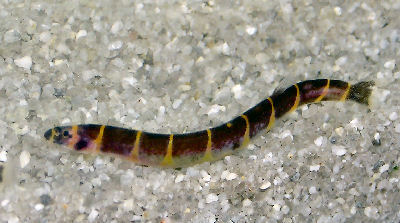Loach - Black Kuhli
Coolie Loach Scientific Name: Acanthopelmus kuhlii
Mon, 30th June, 2025 - 8:34 pm GMT
Sponsor Ads:

Alternative Name
Coolie Loach Scientific Name: Acanthopelmus kuhliiBasic Info
Kuhli Loaches normally reach lengths around three and a half inches (nine centimeters). Their bodies are elongate, and they appear more like the bodies of eels in shape. The body of a Kuhli Loach becomes laterally flattened as it approaches the tail. There are three barbels present on the mouth, and tiny spine-like structures located beneath the eyes that can be raised if the Loach feels it is in danger. Kuhli Loaches can be identified by their dark banding. The bands do not close; rather, they almost meet at the belly but do not touch. Usually 15 to 20 of these dark bands are present over the flank area of the fish and a few are present over the Loach's head. The bands are evenly spaced over the base color of yellow to orange or salmon. The underside of the Kuhli Loach is usually paler than the rest of its body. It should also be noted that many fish sold as Kuhli Loaches are not really Kuhlis. They can be easily mistaken for very similar species that differ mostly in size. The shape and number of the Kuhli's dark bands, and the overall size of the fish can reveal which species it is.
Health
Water temperature for Kuhli Loaches should remain between 70 and 75 degrees Fahrenheit (21 to 24 degrees Celsius). An optimal pH value is 6.3 to 6.8. Water hardness should remain below 80 parts per million. Hiding places of driftwood, live plants, or rocks should be available. For a substrate, very fine gravel with no sharp edges should be used since Kuhli Loaches burrow. Some people recommend sand with a slight covering of peat moss. Cleanliness is important; Kuhli Loaches prefer clear, clean waters. Although Kuhli Loaches are usually peaceful, they may not be kept in all community tanks. This is because larger fish may eat them. In the evening, Kuhli Loaches should be fed live or frozen bloodworms, glassworms, or brine shrimp. Frozen beef heart and plankton are usually offered, in addition to live tubifex worms and fish fry. Some Kuhli Loaches will also eat tablet food. Because of their barbels these loaches and others should be double-bagged on the way home from the store, as they may poke holes in the plastic bags. Breeding No sexual dimorphism is noted in Kuhli Loaches and little is known about their breeding habits. Their eggs are bright green, and it is speculated that some Kuhli Loaches build bubble nests. Others disperse their eggs in aquatic plants. Fry can often be raised on microfoods and newly hatched Cyclops or Artemia.Habitat
Fresh water fish - They are most often found in slow moving bodies of water or streams that have sandy beds.Behavior
Many aquaculturists appreciate the Kuhli Loach because of its useful nature. These fish scavenge for food that falls to the bottoms of their tanks, making them useful as a sort of biological cleaning mechanism. Kuhli Loaches usually scavenge for food in the night. For this reason, they should be fed in the evenings in captivity. Because of this bottom scavenging habit, Kuhli Loaches are often kept by people with community tanks wishing to have a fish that can aid to some degree in maintaining cleanliness. Kuhli Loaches are not schooling fish, but they will do well when kept with other members of their species. This tends to make them more active; owners of single Kuhli Loaches may complain that their fish remains almost perpetually in hiding. When kept in groups, Kuhli Loaches are found to swim about playfully.Origin
ThailandHistory
The Kuhli Loach is native to Java, Borneo, Sumatra, Indonesia, Malaysia, and Thailand.Common Foods
N/ASponsor Ads:
To a weary horse, even his own tail is a burden. -- Unknown
Loach - Black Kuhli
Coded by: BGID® | ALL RIGHTS RESERVED Copyright © 2000-2025
Disclaimer | Privacy | Report Errors / Contact | Credits
















